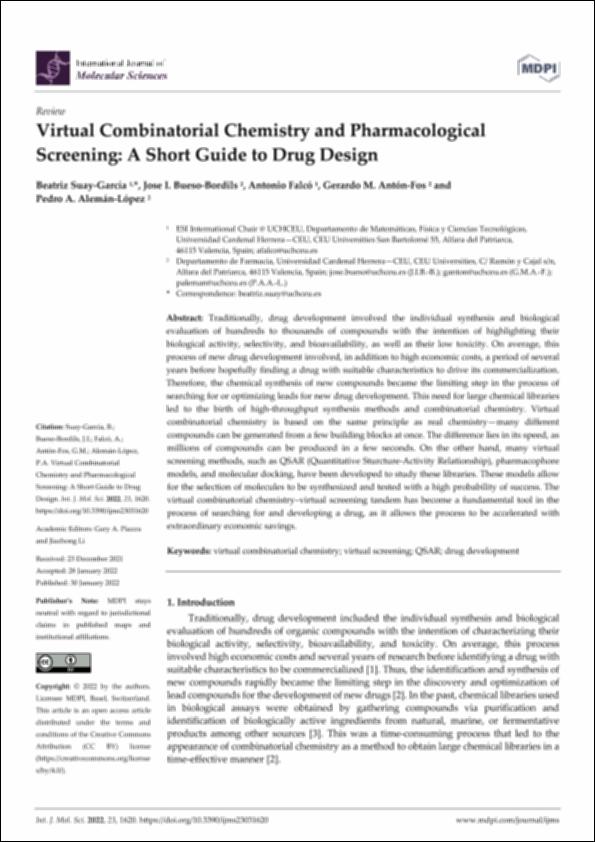Please use this identifier to cite or link to this item:
http://hdl.handle.net/10637/13979Virtual combinatorial chemistry and pharmacological screening : a short guide to drug design
| Title: | Virtual combinatorial chemistry and pharmacological screening : a short guide to drug design |
| Authors : | Suay García, Beatriz Bueso Bordils, José Ignacio Falcó Montesinos, Antonio Antón Fos, Gerardo Manuel Alemán López, Pedro |
| Keywords: | Química farmacéutica.; Salud pública.; Public health.; Pharmaceutical chemistry.; Medicamentos - Análisis.; Química analítica.; Chemistry, Analytic.; Drugs - Analysis. |
| Publisher: | MDPI |
| Citation: | Suay-García, B., Bueso-Bordils, J. I., Falcó, A., Antón-Fos, G. M. & Alemán-López, P. A. (2022). Virtual combinatorial chemistry and pharmacological screening: a short guide to drug design. International Journal of Molecular Sciences, vol. 23, i. 3 (30 jan.), art. 1620. DOI: http://dx.doi.org/10.3390/ijms23031620 |
| Abstract: | Traditionally, drug development involved the individual synthesis and biological evaluation of hundreds to thousands of compounds with the intention of highlighting their biological activity, selectivity, and bioavailability, as well as their low toxicity. On average, this process of new drug development involved, in addition to high economic costs, a period of several years before hopefully finding a drug with suitable characteristics to drive its commercialization. Therefore, the chemical synthesis of new compounds became the limiting step in the process of searching for or optimizing leads for new drug development. This need for large chemical libraries led to the birth of high-throughput synthesis methods and combinatorial chemistry. Virtual combinatorial chemistry is based on the same principle as real chemistry—many different compounds can be generated from a few building blocks at once. The difference lies in its speed, as millions of compounds can be produced in a few seconds. On the other hand, many virtual screening methods, such as QSAR (Quantitative Sturcture-Activity Relationship), pharmacophore models, and molecular docking, have been developed to study these libraries. These models allow for the selection of molecules to be synthesized and tested with a high probability of success. The virtual combinatorial chemistry–virtual screening tandem has become a fundamental tool in the process of searching for and developing a drug, as it allows the process to be accelerated with extraordinary economic savings. |
| Description: | Este artículo se encuentra disponible en la siguiente URL: https://www.mdpi.com/1422-0067/23/3/1620 Este artículo pertenece al número especial "Drug Design and Virtual Screening". |
| URI: | http://hdl.handle.net/10637/13979 |
| Rights : | http://creativecommons.org/licenses/by/4.0/deed.es |
| ISSN: | 2306-7381 (Electrónico) |
| Issue Date: | 30-Jan-2022 |
| Center : | Universidad Cardenal Herrera-CEU |
| Appears in Collections: | Dpto. Farmacia |
Items in DSpace are protected by copyright, with all rights reserved, unless otherwise indicated.


